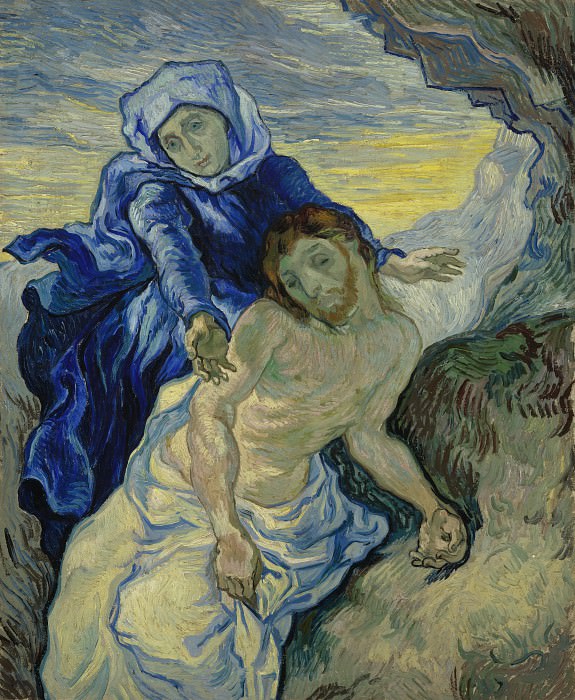Pieta after Delacroix Vincent van Gogh (1853-1890)
Vincent van Gogh – Pieta after Delacroix
Edit attribution
Download full size: 3500×4262 px (5,6 Mb)
Painter: Vincent van Gogh
Location: Van Gogh Museum, Amsterdam.
Vincent Willem Van Gogh painted the painting "Pieta" in 1889.It is executed on oil on canvas. The painting was painted by the artist at the end of his life, during a time of endless depressions and creative searches. However, despite the tragic nature of the events in the life of Van Gogh, this period is the flowering of his creativity. During his last years, the artist depicted more than one hundred and fifty works. The painting "Pieta" appeared in the creative heritage of the artist by accident.
A description of Vincent van Gogh’s painting "Pietà"
Vincent Willem Van Gogh painted the painting "Pieta" in 1889.It is executed on oil on canvas.
The painting was painted by the artist at the end of his life, during a time of endless depressions and creative searches. However, despite the tragic nature of the events in the life of Van Gogh, this period is the flowering of his creativity. During his last years, the artist depicted more than one hundred and fifty works.
The painting "Pieta" appeared in the creative heritage of the artist by accident. Van Gogh dropped a lithograph from Eugène Delacroix’s Pietà into the paint and ruined it. The painter admired the works of Delacroix, tried to understand their performance, the technique of writing. Very sorry for what happened, he decides to reproduce the lost canvas.
The painting is done in a peculiar creative manner of the artist, by that time already entrenched in many of his works. Dark tones and dynamics of light convey tragedy of the plot.
The canvas depicts the Virgin Mary mourning Jesus Christ. Her outstretched arms embrace the dead body of her son. The meek expression on her face attests to the inevitability of the event. The smoothness of the lines used in painting the body of Christ conveys his breathlessness. The painter displays the multiplicity of feelings both through the characters themselves and in the surrounding landscape.
Art historians believe that Van Gogh portrayed Jesus Christ in this painting, identifying his image with himself. Misunderstood, suffering, ridiculed by people and unrecognized in his lifetime - all these things were characteristic of the artist. Many also find an outward resemblance.
The biblical subject matter is not typical of Van Gogh’s work, but at the time of its painting this theme was close to him. He understood the fundamentals of Christianity and yet he was still fully committed to painting.
Кому понравилось
Пожалуйста, подождите
На эту операцию может потребоваться несколько секунд.
Информация появится в новом окне,
если открытие новых окон не запрещено в настройках вашего браузера.
You need to login
Для работы с коллекциями – пожалуйста, войдите в аккаунт (open in new window).




















You cannot comment Why?
The Virgin Mary, draped in a deep, resonant blue robe and a white head covering, leans over Jesus, her face etched with profound sorrow and a gentle, mournful expression. Her hand supports Jesuss limp body, while her other hand reaches out, perhaps in a gesture of solace or disbelief. Jesus, depicted with pale, almost luminous skin, appears lifeless. His body is partially covered by a white cloth, contrasting with the darker tones of the surrounding landscape.
The background is a tumultuous mix of blues, yellows, and greens, suggesting a dramatic or perhaps an otherworldly setting. The swirling patterns in the sky and on the ground create a sense of emotional intensity and unrest, mirroring the grief of the figures. The rough, dark forms of rocks or an earth-like texture frame the scene, adding to the somber and dramatic atmosphere.
The subtexts of this painting are deeply rooted in themes of loss, suffering, and maternal grief. Van Gogh, despite being deeply religious, often expressed his faith through his emotional responses to biblical narratives and his personal struggles. Here, the Pieta – a subject renowned for evoking deep empathy and spiritual contemplation – is reinterpreted through Van Goghs unique emotional lens. The exaggerated colors and dynamic brushwork amplify the sense of anguish and despair, portraying not just Christs sacrifice but the profound sorrow of his mother. The painting can be seen as an exploration of ultimate suffering and the burden of loss, conveyed with raw emotional power. It speaks to universal human experiences of grief and the need for solace in the face of profound tragedy.